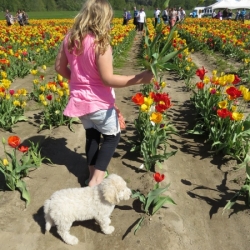


Before getting a dog, its important to consider how the dog will benefit from the relationship and to choose the right dog for your lifestyle.
Article By: Dr Sophia Yin
With 72 million dogs in the U.S. and 400 million dogs worldwide, humans have established many different relationships with dogs. An estimated 3/4 of the world’s population eats dogs and most of the world’s dogs roam the unpaved roads of developing nations, scavenging through human trash and waste like rats. They choose to live and breed near humans because they’re better adapted to scavenging than to hunting.
This is a far cry from our pampered pets who subsist on food formulated by large companies to meet their specific nutritional needs. We’ve not only brought dogs into our house, we’ve developed a whole industry that caters to their needs. Despite this change in status, some say our relationship with dogs isn’t as good as we think.
Says Ray Coppinger, professor of biology at Hampshire University and author of Dogs: A New Understanding of Canine Origin, Behavior and Evolution, “For a true mutualistic relationship, the relationship has to be beneficial to both the human and the dog.” Often the relationship is primarily beneficial for the human.
One reason is that people often underestimate their dog’s needs and consequently end up keeping Fido in conditions that look comfortable but that are impoverished. The problem begins before they acquire the dog.
Says Coppinger, “Often people ask me, ‘What kind of dog should I get?’ I ask them, what kind of dog can you afford to entertain? It’s not like they’re getting a car. If they were getting a car, I’d ask, ‘Do you want to drive fast, feel comfortable?’ When you buy a car or furniture you’re thinking, ‘What’s the benefit to me?’ When people are looking for dogs they forget to ask, ‘What’s the benefit to the dog?'”
How can humans benefit dogs? It starts with an appreciation of the dog’s behavioral profile. Different breeds have been selected for different tasks meaning some breed temperaments match better with certain types of owners. For instance, human shepherds have selected Border collies for ability to herd sheep. Consequently, Border collies are high energy and have an intensified prey drive which shows in the stalking posture they use around sheep—and tennis balls. This drive is carefully controlled by training so that the Border collie doesn’t carry out the attack and kill phase.
For those who haven’t had the opportunity to see a sheep herding trial, you might be surprised how many decisions the dogs make on their own without commands from their handlers. They assess the situation and make choices on how to proceed based on what they see, their instincts and their training. Owners who can’t focus this energy, ability and intellect towards appropriate activities end up having bored, unhappy, problematic dogs.
On the other hand, livestock guarding dogs have been selected to guard sheep. They are less likely to show predatory behavior especially in early puppyhood, so when they’re introduced to sheep as puppies they don’t scare the sheep. As a result, they are able to assimilate into the flock making sheep their social companions. Their mere attachment to the flock, ability to exist peacefully with the sheep, and propensity to bark at intruders makes them good guardians. Their calm demeanor makes them easier than a Border collie for humans to “entertain.”
While working dogs are bred for function, those dogs bred for show are selected for their appearance, their success at dog shows and how well they conform to the “breed standardsâ€. The dog’s personality or temperament is frequently not considered. For instance, one English Springer Spaniel who was extremely successful in the show ring introduced the genetic disorder called Springer Rage by some people (Reisner et al., 2005).

Bred for Diamond Tiaras!
Because show dogs are bred for looks, they differ immensely in both temperament and conformation from dogs of the same breed who came from working lines. In fact, one study involving canine behavioral genetics found what may suggest a genetic split within the Border collie breed—that working lines are genetically different from show lines. (Chang et al., 2009).
As a result, it’s important to know not only what the breed has been selected for historically but what the particular line of dogs was bred for – in other words, learn about the breed’s sub groups and what the attributes are for the different groups. Additionally, since puppies are individuals, realize that not all will fit the breed stereotype.
Once you choose the best breed, sub group and individual for your lifestyle and personality the real work begins.
“Development is a huge part of behavior,” says Coppinger. “It’s not just Labrador retrievers do this and golden retrievers do that. You have to put the dog in the correct environment to be successful.”
For instance the livestock guarding dog that isn’t properly socialized with sheep during the first 16 weeks of life can become a sheep killer rather than a sheep guarder. The brilliant Border collie that leads a kenneled life early on may be forever fearful of other dogs and people or may lack the ability to learn as quickly. These early weeks comprise a crucial period in which they need the appropriate training and socialization to people and animals with whom they will have to interact as adults. This is the time when brain cells grow the most and new nerve cell connections and signal pathways form. Improper raising can lead to improper brain development and improper or even disastrous behavior. The end result is frustration for dog and owner and perhaps limited dog/owner interaction. This social isolation leaves the dog worse off than its scavenging third world counterpart.
With so much at stake for both the dog and the humans involved, Coppinger reminds us that dog ownership is not just about us. What we should be asking is, “What’s the benefit to the dog?“
Make sure to check out Dr. Sophia Yin’s Blog on The Art and Science of Dog Behavior.